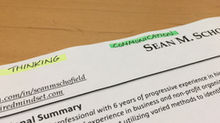Leadership Challenge #9: Learning to Let Go
- smschofield

- Nov 4, 2023
- 3 min read
Updated: Aug 23
As I drove past the two trees (pictured above), I had to turn around, pull over, and grab a few pictures. At first glance, I saw an act of beneficence... one tree holding the other up. After I walked around them, I realized that the tree on the right was dead… fully detached from the stump, about six inches above the ground.
Because I’m me, I immediately thought about leadership. Specifically, how we are often quick to celebrate a person who unquestioningly carries the weight of the fallen tree. However, less often do we stop and think about whether or not the weight is worth carrying.
Working hard is not synonymous with working smart.
"Dead Wood," in a leadership context, refers to elements (individuals, projects, or strategies) that no longer contribute positively to the team's objectives or the organization's vision. These elements may have once been viable or even successful, but as circumstances change, they become obstacles rather than assets. Recognizing this distinction is a crucial first step for leaders seeking to harness the superpower of letting go. Shouldering the weight of that dead tree is not evidence of good, but evidence of a leader's inability to take the hard, decisive action of letting go of something that is no longer in the team's best interest. Sometimes a difference between a great leader and a mediocre leader is the ability to identify what is dead wood, and the courage to drop it. To do this, a leader must objectively analyze whether the COST of carrying the tree exceeds the BENEFIT of carrying the tree.
A Cost-Benefit Analysis (CBA) is straightforward and pragmatic... but due to our subjective nature, sometimes a challenging process. If you've never applied a CBA, this article by Tim Stobierski can help you familiarize yourself with the advantages and shortfalls of the process. To be strategic about employing a CBA, especially if you are operating in a service (or educational) organization, it is essential to remember that not all costs or benefits are monetary. Sometimes time and opportunity costs are more significant than dollars and cents, and likewise, sometimes intangible benefits (like the effect on a team's culture) are worth far more than the potential revenue that is generated.
Forcing your team to carry dead wood will always harm the team's culture.
Leaders often struggle to shed the dead wood because they are emotionally tethered to the sapling that they nurtured from seed. This is a sunk cost. Other times, leaders are compelled to keep a process moving forward because of stakeholder (sometimes their direct manager's) demands. This represents a different, important challenge of leadership. Utilizing a strategy like a CBA can be a powerful way to "manage up," especially if you are able to offer a sensible, parallel plan to the stakeholder's demand. If a formal CBA feels like a lot to bite off, start with a simple pro/con list. Here are some questions to fuel your thinking:
Who can most accurately determine whether the tree is dead wood or can be saved?
How will stakeholder(s) be affected if the tree is dropped?
What are all of the costs (financial, opportunity, time, etc.) of carrying the tree? Also, what are all of the costs of ditching the dead wood?
What are the tangible, intangible, cultural, and other benefits of carrying or freeing yourself and your team from the tree?
Does the tree represent more than itself (is it an organizational hero, idol, or an essential piece of the organization -- or did a senior leader plant, nurture, or speak widely about the tree)?
As a leader, you'll sometimes find yourself carrying the weight of the dead tree, and that's unavoidable... but sometimes, all it takes is a bit of objective evidence that the wood is dead, a reasonable and defensible stance on the cost of carrying the dead wood or the benefit of dropping it, an alternative plan of action (not just to drop and ditch the tree where it stands), and some conviction/fortitude when having your conversations to free yourself from shouldering a burden that is not worth its weight.





![The Three Most Important Tools in the [Insert Role Here] Toolbox](https://static.wixstatic.com/media/95563e_ea80203fa49e4ce8973aad36dc9d82e0~mv2.png/v1/fill/w_447,h_250,fp_0.50_0.50,q_35,blur_30,enc_avif,quality_auto/95563e_ea80203fa49e4ce8973aad36dc9d82e0~mv2.webp)
![The Three Most Important Tools in the [Insert Role Here] Toolbox](https://static.wixstatic.com/media/95563e_ea80203fa49e4ce8973aad36dc9d82e0~mv2.png/v1/fill/w_220,h_123,fp_0.50_0.50,q_95,enc_avif,quality_auto/95563e_ea80203fa49e4ce8973aad36dc9d82e0~mv2.webp)
































Comments